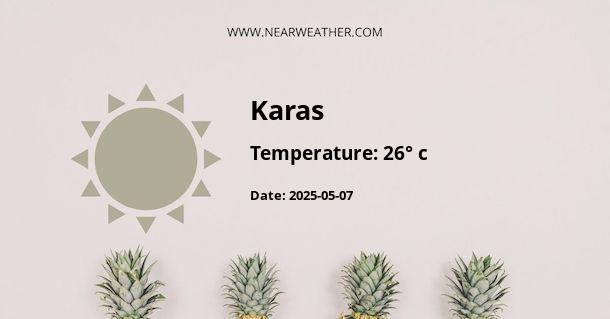Karas, Namibia - Climate and Weather Overview
Karas is a region in the southern part of Namibia, known for its diverse landscapes, including the Namib Desert, Naukluft Mountains, and the Fish River Canyon. The region experiences a fascinating climate, characterized by hot and arid conditions, making it an intriguing destination for travelers and a unique location to study weather patterns.
Annual Climate Summary for Karas
The climate in Karas is classified as arid, with very little rainfall throughout the year. The region experiences hot temperatures during the day and cooler temperatures at night. Understanding the climatic conditions is essential for visitors and residents to make informed decisions about their daily activities and travel plans.
Temperature
The temperatures in Karas can vary significantly throughout the year. In the summer months, which span from November to February, temperatures can soar to high levels, often exceeding 40°C (104°F). The winter months, from June to August, bring cooler temperatures, with daytime highs reaching a more moderate 20-25°C (68-77°F). Nighttime temperatures can drop considerably, especially during the winter, often falling below 10°C (50°F).
The following table illustrates the average high and low temperatures in Karas throughout the year:
| Month | Average High (°C) | Average Low (°C) |
|---|---|---|
| January | 37 | 20 |
| April | 31 | 15 |
| July | 20 | 6 |
| October | 29 | 14 |
Rainfall
Karas experiences very low levels of precipitation, with the majority of the rain falling between November and March. The annual rainfall in the region averages around 50-150 millimeters. The dry climate and low precipitation contribute to the arid conditions that define the area.
Weather Patterns and Phenomena
The weather patterns in Karas are influenced by its geographic location, with the Namib Desert to the west and the Naukluft Mountains to the east. The region is known for its clear skies and abundant sunshine, making it an ideal location for solar energy generation.
The prevailing winds, such as the cool coastal breeze known as the "bergwind," play a significant role in regulating temperatures and influencing weather conditions in the region. These winds contribute to the arid climate and help shape the unique landscape of Karas.
Best Time to Visit Karas
Due to its arid and hot climate, the best time to visit Karas is during the winter months, from June to August, when temperatures are more moderate and suitable for outdoor activities such as hiking and sightseeing. However, visitors should be prepared for significant temperature variations between day and night.
It's important to note that the summer months, while hot, can also provide a unique experience for travelers interested in desert landscapes and wildlife, despite the intense heat.
Conclusion
Karas, Namibia, offers a distinctive climate characterized by hot and arid conditions, with minimal precipitation and significant temperature variations throughout the year. Understanding the climate and weather patterns is essential for anyone planning to visit or live in this region, as it allows for better preparation and enjoyment of all that Karas has to offer.
A - Karas's Latitude is -27.000000 & Longitude is 17.500000.
A - Weather in Karas is 16° today.
A - Climate Conditions in Karas shows clear sky today.
A - Humidity in Karas is 67% today.
A - Wind speed in Karas is 13.46 km/h, flowing at 185° wind direction. today.
